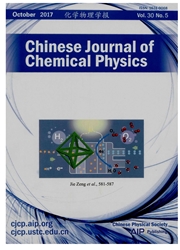

 中文摘要:
中文摘要:
两亲性磷脂分子能够形成各种不同形态的胶束,其结构形成不仅依赖于磷脂分子结构和组成,还依赖于两亲性分子的自组装路径.本工作采用粗粒化分子动力学方法模拟研究了二棕榈酰磷脂酰胆碱(DPPC)与十六烷基磷酸胆碱(HPc)混合磷脂球胶束化行为.通过调节DPPC/HPC的组分比例和磷脂球尺寸,观察到多种不同胶束结构形成,例如:球形和非球形(扁平或长椭球)囊泡、盘形胶束、单环或双环胶束和蠕虫状胶束.研究发现,由于原位胶束化作用,采用磷脂球作为初始态有利于形成囊泡和环形拓扑结构胶束.模拟结果表明,结合初始态结构设定同时调节磷脂分子组成是一种有效调控磷脂胶束结构的方法.
 英文摘要:
英文摘要:
Amphiphilic lipid molecules can form various micelles depending on not only their molecular composition but also their self-assembly pathway. In this work, coarse-grained molecular dynamics simulations have been applied to study the micellization behaviors of mixed dipalmitoylphosphatidylcholine (DPPC)/hexadecylphosphocholine (HPC) droplets. By vary- ing DPPC/HPC composition and the size of lipid droplets, various micelles such as spherical and nonspherical (oblate or prolate) vesicles, disk-like micelles, double or single ring-like and worm-like micelles were observed. It is found that the lipid droplet as an initial state favors forming vesicles and ring-like micelles due to in situ micellization. Our simulation results demonstrate that using special initial conditions combined with various molecular compositions is an effective way to tune lipid micellar structure.
 同期刊论文项目
同期刊论文项目
 同项目期刊论文
同项目期刊论文
 DISSIPATIVE PARTICLE DYNAMICS SIMULATION ON THE EFFECT OF LINE TENSION ON BENDING RIGIDITY OF BILAYE
DISSIPATIVE PARTICLE DYNAMICS SIMULATION ON THE EFFECT OF LINE TENSION ON BENDING RIGIDITY OF BILAYE Microfluidic fabrication and thermoreversible response of core/shell photonic crystalline microspher
Microfluidic fabrication and thermoreversible response of core/shell photonic crystalline microspher Thermodynamic and conformational insights into the phase transition of a single flexible homopolymer
Thermodynamic and conformational insights into the phase transition of a single flexible homopolymer Structural Transformation of Diblock Copolymer/Homopolymer Assemblies by Tuning Cylindrical Confinem
Structural Transformation of Diblock Copolymer/Homopolymer Assemblies by Tuning Cylindrical Confinem Reaction Kinetics of Nonideal Hyperbranched Polymerizations: Influences of Chain Rigidity and Reacti
Reaction Kinetics of Nonideal Hyperbranched Polymerizations: Influences of Chain Rigidity and Reacti Kinetics of multicompartment micelle formation by self-assembly of ABC miktoarm star terpolymer in d
Kinetics of multicompartment micelle formation by self-assembly of ABC miktoarm star terpolymer in d Computer simulation of the formation of anti-fouling polymeric ultrafiltration membranes with the ad
Computer simulation of the formation of anti-fouling polymeric ultrafiltration membranes with the ad ABC triblock copolymer particles with tunable shape and internal structure through 3D confined assem
ABC triblock copolymer particles with tunable shape and internal structure through 3D confined assem Melting processes of oligomeric alpha and beta isotactic polypropylene crystals at ultrafast heating
Melting processes of oligomeric alpha and beta isotactic polypropylene crystals at ultrafast heating A coarse-grained molecular dynamics - reactive Monte Carlo approach to simulate hyperbranched polyco
A coarse-grained molecular dynamics - reactive Monte Carlo approach to simulate hyperbranched polyco Self-assembly of Janus ellipsoids: a Brownian dynamics simulation with a quantitative nonspherical-p
Self-assembly of Janus ellipsoids: a Brownian dynamics simulation with a quantitative nonspherical-p Adsorption of polyethylenimine and its interaction with a genomic DNA on a silicon oxynitride surfac
Adsorption of polyethylenimine and its interaction with a genomic DNA on a silicon oxynitride surfac Enhancing the efficiency of lithium intercalation in carbon nanotube bundles using surface functiona
Enhancing the efficiency of lithium intercalation in carbon nanotube bundles using surface functiona Encapsulation of inorganic nanoparticles into block copolymer micellar aggregates: Strategies and pr
Encapsulation of inorganic nanoparticles into block copolymer micellar aggregates: Strategies and pr A smart DNA-gold nanoparticle probe for detecting single-base changes on the platform of a quartz cr
A smart DNA-gold nanoparticle probe for detecting single-base changes on the platform of a quartz cr DNA Polymer Brush Patterning through Photocontrollable Surface-Initiated DNA Hybridization Chain Rea
DNA Polymer Brush Patterning through Photocontrollable Surface-Initiated DNA Hybridization Chain Rea 期刊信息
期刊信息
